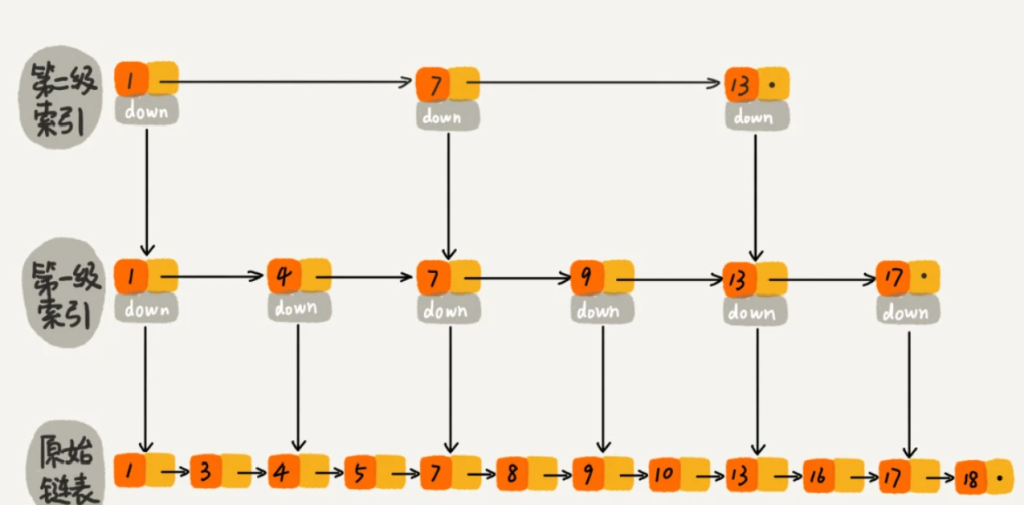本文最后更新于380 天前,其中的信息可能已经过时,如有错误请发送邮件到yuan140457@gmail.com
基于跳表实现的轻量键值对数据库。在随机读写情况下,该引擎每秒在多个并发线程下的累计执行成功次数都可以保持在30000左右。
1. 技术栈
- 基于跳表结构使用面向对象与泛型编程思想,对节点类与跳表类进行抽象与封装
- 使用互斥锁,防止并发插入数据时发生冲突
- 使用MakeFile的多文件编译方式
2. 对外接口
- insertElement (插入数据)
- deleteElement (删除数据)
- searchElement (查询数据)
- showSkipList (展示已存数据)
- dumpFile (数据落盘)
- loadFile (加载数据)
- getSize (返回数据规模)
3. 跳表的原理
跳表是在一个原始链表中添加了多级索引,通过每一级索引来进行二分搜索的数据结构,其架构如下:

在上述跳表中,假如查询key=10的记录,则可以从第二级索引开始快速定位:
- 遍历第二级索引,从1开始,发现7<10<13,7就是该层要找的索引,通过它跳到下一级索引
- 遍历第一级索引,从7开始,发现9<10<13,9就是该层要找的索引,通过它跳到下一级索引
- 遍历原始链表,从9开始,发现10=10,10就是该层要找的最终索引
相比于直接遍历原始链表,多级索引的存在使跳表查询效率更快,总结:
跳表的优点: 可以实现高效的插入、删除和查询 ,时间复杂度为O(logn).
跳表的缺点:需要存储多级索引,增加了额外的存储空间
跳表的用途:经典的以空间换时间的数据结构,常用于非关系数据库的存储引擎中
4. 跳表节点的实现
对于每个节点来说都需要保存它下一个节点的指针,所以我们的节点类可以定义如下:
/* 元素节点的类模板 */
template <class K, class V>
class Node {
public:
/*默认构造 构造 与 析构函数*/
Node() {}
Node(K key, V value, int level);
~Node();
/*获取键值对 K V */
K getKey() const;
V getValue() const;
/*设置值 V */
void setValue(const V &value);
public:
Node<K,V> **forward;
int node_level;
private:
K key;
V value;
};5. 跳表的插入与删除
5.1 插入操作
跳表的插入负责构建整个跳表,是跳表中最难的需求。跳表的插入原理如下:

在上图中,要插入一个节点6,则要在多个层都插入这个节点6,这个多个层要可能随机,保证每一层都比上一层的节点少一半。
template <typename K, typename V>
bool SkipList<K, V>::insertElement(K key, V value) {
// 上锁
mtx.lock();
//
Node<K,V> *current = this->head;
// 定义一个 update 数组用来存放 current->forward[i]操作之后的元素
Node<K, V> *update[this->maxLevel + 1];
memset(update, 0, sizeof(Node<K,V> *) * this->maxLevel + 1);
// 跳表由高到低进行遍历找到需要插入的位置
for (int i = this->currentLevel; i >= 0; i--) {
// 当当前层级的下一个节点不为空且该key小于要插入的key就往右遍历
while (current->forward[i] != nullptr && current->forward[i]->getKey() < key) {
current = current->forward[i];
}
// 否则就将该节点放入需要进行更新的数组 update 中
update[i] = current;
}
// 当到达 level 0 层级时,将指针指向右节点,也就是希望插入键的节点
current = current->forward[0];
// 如果当前节点的键等于搜索到的键,那么证明已经存在该节点了
if (current != nullptr && current->getKey() == key) {
current->setValue(value);
mtx.unlock();
return true;
}
// 如果 current 为 NULL,则表示我们已到最底层
// 如果 current 的键不等于 key,这意味着我们必须在 update[0] 和当前节点之间插入节点
if (current == nullptr || current->getKey() != key) {
// 先为新节点分配随机的 level/层数
int randomLevel = getRandomLevel();
// 如果随机层数大于跳表当前最大的层数,那么就用头节点来初始化update数组
/*
假设当前跳表的最高层级 currentLevel 为 2,而生成的随机层级 randomLevel 为 4。
在这种情况下,需要扩展 update 数组和更新 currentLevel。
进入 for 循环,i 的初始值为 currentLevel+1,即 3。
在第一次迭代中,i 的值为 3,执行 update[3] = heade,即将 update[3] 赋值为头点。
在第二次迭代中,i 的值为 4,执行 update[4] = heade,即将 update[4] 赋值为头点。
for 循环结束后,update 数组扩展为 [空, 空, 空, 头节点, 头节点]。
然后,将 currentLevel 更新为 randomLevel,即将 currentLevel 更新为 4。
*/
if (randomLevel > this->currentLevel) {
for (int i = this->currentLevel + 1; i <= randomLevel + 1; i++) {
update[i] = this->head;
}
this->currentLevel = randomLevel;
}
// 为新节点分配空间
Node<K,V>* newNode = creatNode(key,value,randomLevel);
// 插入该节点
for (int i = 0; i <= randomLevel; i++) {
newNode->forward[i] = update[i]->forward[i];
update[i]->forward[i] = newNode;
}
std::cout << "Successfully inserted key:" << key << ", value:" << value << std::endl;
this->elementCount++;
}
mtx.unlock();
return true;
}5.2 删除操作
template <typename K, typename V>
bool SkipList<K, V>::removeElement(K key) {
mtx.lock();
Node<K,V> *current = this->head;
Node<K,V> *update[this->currentLevel + 1];
memset(update, 0, sizeof(Node<K,V> *) * (this->currentLevel + 1));
// 从高到低进行查找
for (int i = this->currentLevel; i >= 0; i--) {
while (current->forward[i] != nullptr && current->forward[i]->getKey() < key) {
current = current->forward[i];
}
update[i] = current;
}
current = current->forward[0];
if (current != nullptr && current->getKey() == key) {
// 从 level 0 开始,在每一层删除当前的节点
for (int i = 0; i < this->currentLevel; i++) {
// 如果下一个节点不是目标节点,则中断循环。
if (update[i]->forward[i] != current) {
break;
}
// 否则就让需要删除的节点的前一个指向后一个
update[i]->forward[i] = current->forward[i];
}
// 删除没有元素的层级
while (this->currentLevel > 0 && current->forward[this->currentLevel] == 0) {
this->currentLevel--;
}
std::cout << "Successfully deleted key "<< key << std::endl;
delete current;
this->elementCount--;
}
mtx.unlock();
return true;
}6. 小结
跳表使用空间换时间的设计思路,通过构建多级索引来提高查询的效率,实现了基于链表的“二分查找”。跳表是一种动态数据结构,支持快速地插入、删除、查找操作,时间复杂度都是 O(logn)。
跳表的空间复杂度是 O(n)。不过,跳表的实现非常灵活,可以通过改变索引构建策略,有效平衡执行效率和内存消耗。